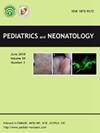Lung ultrasonography in the management of preterm (≤34 weeks) neonates with respiratory distress syndrome
IF 2.1
4区 医学
Q2 PEDIATRICS
引用次数: 0
Abstract
Introduction
The diagnosis of respiratory distress syndrome (RDS) is largely clinical with the support of a chest X-ray. Lung ultrasound (LUS) is emerging as a reliable bedside technique to evaluate RDS.
Aims and objectives
To determine the LUS for preterm neonates ≤34 weeks of gestation admitted within 12 h of birth with clinical suspicion of RDS and to compare the lung USG score with the chest X-ray score to predict the need for surfactant administration.
Methods
This prospective observational study was conducted among 67 preterm neonates with clinical suspicion of RDS admitted to our NICU. Neonates underwent a clinical examination, followed promptly by a chest X-ray and LUS. The decision to administer surfactant was made on the basis of the clinical picture and chest X-ray. The NICU team was blinded to the findings of LUS, and the radiologist was blinded to the X-ray chest report.
Results
More than two-thirds (67.2%) of the enrolled neonates with clinical suspicion of RDS required surfactant administration. The median LUS score was 12 among those who needed surfactant, while it was 8 for those who did not need surfactant. A receiver operator curve was constructed for the LUS and chest X-ray scores to determine the need for surfactant administration. The area under the curve (AUC) for the LUS score was higher than that of the chest X-ray score (0.962 vs. 0.811; p < 0.001) for predicting the need for surfactant administration. The sensitivity and specificity for the LUS and chest X-ray scores were 95.6% versus 93.3% and 91% versus 50%, respectively.
Conclusion
The LUS score is more useful than the chest X-ray score for determining the need for surfactant in preterm neonates with RDS suspicion.
肺超声检查在早产儿(≤34周)新生儿呼吸窘迫综合征中的应用。
简介:呼吸窘迫综合征(RDS)的诊断在很大程度上是临床与胸部x线片的支持。肺超声(LUS)正在成为一种可靠的床边技术来评估RDS。目的:确定临床怀疑有RDS的出生12 h内≤34孕周的早产儿LUS,比较肺USG评分与胸部x线评分,预测是否需要表面活性剂。方法:对我院新生儿重症监护室收治的67例临床疑似RDS的早产儿进行前瞻性观察研究。新生儿接受临床检查,随后立即进行胸部x光和LUS检查。根据临床表现和胸片决定给予表面活性剂。NICU小组对LUS的发现不知情,放射科医生对胸部x光片报告不知情。结果:超过三分之二(67.2%)临床怀疑有RDS的新生儿需要表面活性剂治疗。需要表面活性剂的患者中位LUS评分为12分,而不需要表面活性剂的患者中位LUS评分为8分。构建了LUS和胸片评分的接受者操作曲线,以确定是否需要使用表面活性剂。LUS评分的曲线下面积(AUC)高于胸片评分(0.962 vs. 0.811;结论:LUS评分比x线胸片评分更有助于判断疑似RDS的早产儿是否需要表面活性剂。
本文章由计算机程序翻译,如有差异,请以英文原文为准。
求助全文
约1分钟内获得全文
求助全文
来源期刊

Pediatrics and Neonatology
PEDIATRICS-
CiteScore
3.10
自引率
0.00%
发文量
170
审稿时长
48 days
期刊介绍:
Pediatrics and Neonatology is the official peer-reviewed publication of the Taiwan Pediatric Association and The Society of Neonatology ROC, and is indexed in EMBASE and SCOPUS. Articles on clinical and laboratory research in pediatrics and related fields are eligible for consideration.
 求助内容:
求助内容: 应助结果提醒方式:
应助结果提醒方式:


